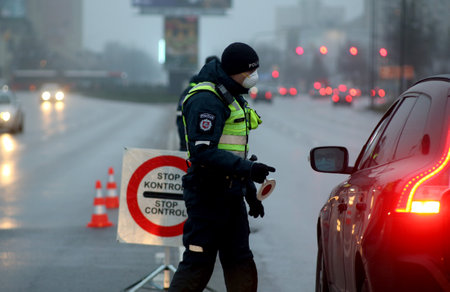1. Introduction to Police Reports in Car Accidents
When a car accident occurs, one of the most important documents involved is the police report. This report is created by law enforcement officers who respond to the accident scene. It provides an official account of what happened and includes key details that can be crucial when filing an insurance claim or pursuing legal action.
A police report typically contains essential information such as:
| Information Included | Details |
|---|---|
| Date, Time, and Location | Records when and where the accident took place. |
| Driver and Vehicle Information | Includes names, contact details, and vehicle descriptions. |
| Witness Statements | Statements from bystanders who saw the accident. |
| Officer’s Observations | Notes on road conditions, weather, and any visible damages. |
| Preliminary Fault Assessment | Indication of who may be at fault, based on initial findings. |
The significance of a police report in a car accident claim cannot be overstated. Insurance companies and courts often rely on these reports to determine what happened and to assess liability. Because the report is written by an impartial third party—a police officer—it is generally considered a credible source of information. In many cases, having a well-documented police report can strengthen an insurance claim and help ensure a fair settlement.
Understanding what a police report includes and why it matters is essential for anyone involved in a car accident. In the next section, we will explore how to obtain a police report and use it effectively in an accident claim.
2. How Police Reports Impact Insurance Claims
When you’re involved in a car accident, one of the most important documents in your insurance claim is the police report. This report provides an objective account of the incident and plays a crucial role in determining fault and influencing the settlement process.
Determining Fault
Insurance companies rely on police reports to help determine who was at fault in an accident. While the report itself does not legally establish liability, it provides valuable details such as:
- The officer’s assessment of the scene
- Statements from drivers, passengers, and witnesses
- Traffic law violations that may indicate fault
- Any contributing road or weather conditions
These details help insurers decide how to distribute responsibility and which party should be held accountable for damages.
Influencing Insurance Settlements
Police reports also impact the negotiation process between insurance companies. If the report clearly supports one party’s claim, their insurer may approve a payout more quickly. On the other hand, if the details are unclear or disputed, insurers may conduct further investigations. Here’s how a police report can influence settlements:
| Police Report Details | Impact on Insurance Settlement |
|---|---|
| Clear determination of fault | Faster claim processing and settlement |
| Conflicting witness statements | Additional investigation required, possibly leading to delays |
| Traffic law violations noted | The at-fault driver’s insurance may have to cover damages |
| Unclear or missing details | May result in disputed claims or shared liability |
Because of the influence a police report has on insurance claims, it’s always a good idea to call law enforcement after an accident, even if the damage seems minor.
![]()
3. Key Information Found in a Police Report
When filing an accident claim, the details included in a police report can significantly impact the process. Understanding the key pieces of information that officers document can help you navigate your claim more effectively.
Essential Details in a Police Report
A police report typically contains various types of important information that can influence your car accident claim. Below are some of the critical details commonly found:
| Category | Details Included |
|---|---|
| Date, Time, and Location | Records when and where the accident occurred, crucial for claim validation. |
| Involved Parties | Includes names, contact details, driver’s licenses, and insurance information of all involved drivers. |
| Vehicle Information | Documents vehicle makes, models, license plates, and damages sustained. |
| Witness Statements | Provides statements from people who saw the accident, which can support your version of events. |
| Officer’s Observations | Details about road conditions, weather, traffic signals, and other situational factors. |
| Citations or Violations | Identifies if any drivers received tickets or were found violating traffic laws. |
| Preliminary Fault Assessment | Some reports may include the officer’s opinion on who was at fault. |
Why This Information Matters
Each piece of information plays a role in how insurance companies assess fault and liability. Having accurate data from the police report helps validate your claim and ensures that all essential details are documented properly.
How to Obtain a Police Report
If you’ve been involved in a car accident, obtaining the police report is crucial for your claim. You can typically request a copy from the local law enforcement agency or your insurance provider. Be sure to review it for accuracy and correct any errors if necessary.
4. Challenging Errors in a Police Report
Police reports play a crucial role in car accident claims, but they arent always 100% accurate. Mistakes can happen, whether its a wrong detail about the crash, incorrect contact information, or even an inaccurate statement from a witness. If you find an error in your police report, dont worry—there are ways to challenge and correct it.
Steps to Correct an Inaccurate Police Report
If you notice a mistake in your police report, follow these steps to request a correction:
1. Review the Report Carefully
First, obtain a copy of the police report and go over it thoroughly. Highlight any incorrect details or missing information.
2. Gather Supporting Evidence
To correct a mistake, youll need proof. This could include:
- Photos or videos from the accident
- Witness statements
- Medical records
- Dashcam footage
- Insurance documents
3. Contact the Officer Who Filed the Report
Find out which officer handled your accident report. Their contact information is usually listed on the document. Politely reach out and explain the inaccuracies. Be prepared with your evidence to support your request.
4. Submit a Written Request
Some police departments require a formal written request to make changes. Be clear about what needs to be corrected and attach any supporting documents.
5. Follow Up Persistently
Corrections dont always happen instantly. Follow up with the department to ensure your request is processed. Keep records of all conversations and correspondence.
What If the Officer Refuses to Make Changes?
Not all errors can be corrected easily. If the officer refuses to change the report, you may be able to submit a Supplemental Statement. This allows you to officially document your concerns and add relevant information to the report.
Common Errors in Police Reports
Mistakes in police reports typically fall into one of two categories: factual errors and disputed details.
| Type of Error | Description | How to Correct It |
|---|---|---|
| Factual Error | Includes mistakes like incorrect name spellings, wrong vehicle details, or recording the wrong date/time. | These errors are usually easy to fix by providing the correct documents, such as your drivers license or vehicle registration. |
| Disputed Details | Includes subjective details like who was at fault or how the accident occurred. | These are harder to correct. You may need to submit additional evidence, such as witness statements or photos, and possibly a Supplemental Statement. |
Why Accurate Police Reports Matter
Insurance companies rely heavily on police reports when processing claims. If there are inaccuracies that make you look responsible for the accident when you weren’t at fault, it could impact your insurance payout. Taking action to correct errors can help ensure that your claim is treated fairly.
5. Steps to Obtain a Copy of a Police Report
A police report is an essential document when filing a car accident claim. It provides an official record of the incident, details about the parties involved, and any findings from the responding officers. If you need to obtain a copy of a police report, follow these steps:
Step 1: Identify the Law Enforcement Agency
Determine which law enforcement agency responded to the accident. This could be a local police department, a county sheriffs office, or a state highway patrol agency.
Step 2: Gather Necessary Information
Before requesting a report, collect the following details to help locate the record:
| Required Information | Details |
|---|---|
| Date and time of the accident | When the incident occurred |
| Location of the accident | Street name, intersection, or highway |
| Case or report number | If provided by the officer at the scene |
| Names of involved parties | Driver names and/or vehicle information |
Step 3: Contact the Law Enforcement Agency
Most agencies allow report requests online, by mail, or in person. Visit the agencys website or call their records department to confirm the process and any fees involved.
Step 4: Submit Your Request
Depending on the agency, you may need to complete a request form, show identification, and pay a small fee. Some jurisdictions allow online access, while others require you to pick up a physical copy or receive one by mail.
Step 5: Receive and Review the Report
Once you obtain the police report, review it carefully for accuracy. If you find any mistakes, you may request corrections from the agency.
Why This Matters in a Car Accident Claim
A police report serves as an objective record that insurers use to help determine fault and liability. It supports your claim by providing essential details, including witness statements and officer observations. Having a copy can be crucial when negotiating compensation or if legal action is necessary.

